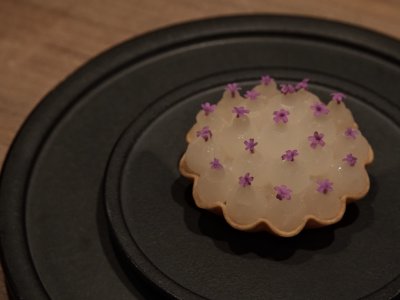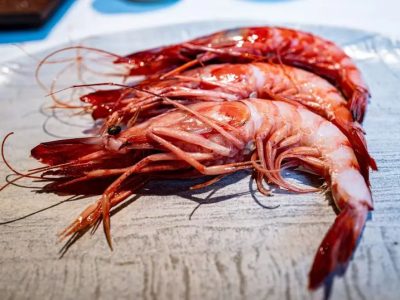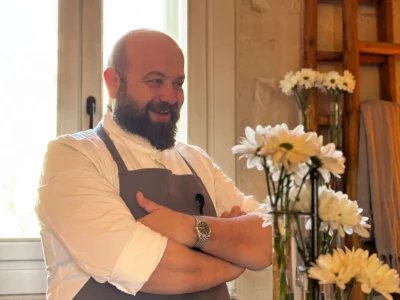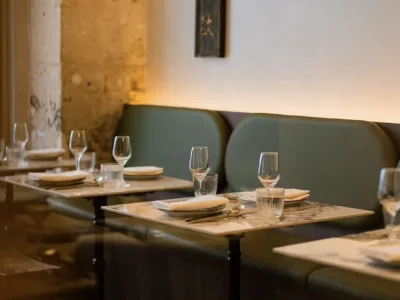In my career as a culinary writer, I have had the privilege of speaking with many outstanding chefs, but my conversation with Eiji Taniguchi was unforgettable. His background and culinary journey took many unexpected turns. Immersed in the world of cooking from a young age, his initial dream was to become a chef of Japanese cuisine, but fate led him down a different path.
L’evo@Jocelyn華姐的TastyTrip
"I was born into a family of chefs in Osaka, where my parents ran a tonkatsu restaurant. I grew up watching them cook, so I dreamed of becoming a chef, initially of Japanese cuisine. After high school, I worked at a hotel with two divisions: one focused on Japanese cuisine and the other on European cuisine. I wanted to join the Japanese division, but the company assigned me to the European division," Taniguchi explained. "During that time, the Great Hanshin Earthquake occurred, causing severe destruction. Everything collapsed, including my workplace, which was badly damaged. After that, I continued my culinary education, focusing on European cuisine. My journey in French cuisine began in Japan. In 2005, I went to France, where I trained under Bernard Loiseau, who tragically took his own life later. Despite such a tragedy, I persevered and studied for two more years before returning to Japan."
 Chef Eiji Taniguchi
Chef Eiji Taniguchi
"Why did you initially move to Toyama?" "Actually, I didn't want to move to Toyama in the beginning. I wanted to pursue my culinary career in a city or in the countryside, but unexpectedly, my company suddenly told me to go to Toyama. At first, I was resistant to the idea because hotels are established in various places, in different regions. But when my company asked me to go, I had no choice." he explained.
As he adapted to the new environment, his cooking style also evolved. Chef Taniguchi came to Toyama about fourteen years ago, and since then he personally visited farmers and fishermen, building connections. Understanding all the ingredients and suppliers took about five years, and he admits he is still learning. Toyama Prefecture is nestled between the Sea of Japan and the mountains, boasting rich resources from both land and sea.
He opened L'évo, meaning "evolution," in the southern part of Toyama City in 2014 and relocated in December 2020 to Toga Village in Toyama Prefecture - a secluded mountain village with only 500 residents. The initial challenges of the relocation were significant: "It was very tough at the beginning because there was a lot of snow, and all the roads were buried, about three meters or more. It was very difficult to get through the winter at the beginning, all the staff had to go out to shovel snow," he recalled. The restaurant occupies 7,500 square meters, has accommodation facilities, and is located in a very beautiful spot overlooking the Toga River. It is said that five hundred million yen was spent on establishing it, and Chef Taniguchi also mentioned the huge loan with a wry smile, so the restaurant is open all year round except in August due to pest issues, and it only closes one day a week, with the chef always present.
My own fascination with destination restaurants far exceeds many people's imaginations. Part of my admiration is for chefs who pioneer in the wilderness. Where does their courage come from? To break new ground in hard-to-reach destinations and face the challenges that come with it. Another part can more fully taste the local terroir. To enrich the dishes, chefs at destination restaurants must do their utmost to study local ingredients and build close relationships with local fishermen, farmers, and even hunters, making terroir and so-called destination restaurants all the more intertwined.
Reaching L’évo is not easy. Toga Village, where the restaurant is located, is surrounded by peaks over 1,000 meters high and verdant canyons. It takes a 90-minute drive from Toyama City or Kanazawa City, with winding mountain roads. When I arrived in March this year, there was still snow along the way.

This reminded me of my last visit to the two Michelin-starred restaurant Faviken in northern Sweden before it closed, also amidst heavy snowfall. Upon arriving at L’évo, its dark gray roof stood out starkly against the snowy landscape. Inside the waiting area of the restaurant, one can see through large windows while guests await their meals. Stepping into the restaurant reveals an open kitchen where chefs busily prepare dishes.
The amuses-bouches hinted at “sampling” local ingredients, featuring goat cheese gougères, red snapper potato mash fried balls with parsley breadcrumbs, and beet meringue with chicken liver mousse, bright pink and somewhat out of place, but the chicken liver mousse seemed justifiable. Grilled Toyama white shrimp paired with mochi rice cakes was a particularly favorite appetizer, lightly smoked over charcoal to enhance its sweetness. The lightly seared skipjack tuna, paired with fish liver and tender sprouts with a refreshing aroma, was served with a creamy sauce rich in bonito and nutty flavors, elegantly refined, showcasing culinary skills in ingredient preparation: delicious!
The following classic dish, sardines from Himi City in Toyama, mixed with chopped wasabi and black olives, accompanied by chicory, broccoli, and scallions, laid on a crispy pastry base. A taste that captivated hearts, a meticulous technique that allowed the ingredients to shine, fresh and layered with vegetable notes, a heartwarming dish.
 Sardine
Sardine
Thinly sliced octopus, lightly grilled to add a smoky aroma, including chopped bamboo shoots, perilla, and plum sauce. L’évo’s use of charcoal reminded me of the culinary techniques at Asador Etxebarri, where all seafood is gently kissed by charcoal flames, enhancing sweetness rather than being char-grilled. I’ve tasted many restaurants where octopus is thinly sliced like pasta, but L’évo’s daring artistry left a lasting impression. How could each seafood dish maintain such brilliance? By this point, I clearly knew I wanted to visit again.
Young bear meat tartare, thinly sliced moon bear leg meat, aged for two months, was chosen for its lean cuts to allow diners to taste the bear meat. It was paired with fern, thistle sauce, and honey jelly, delicately seasoned to make the bear meat even more refined. As honey is a part of the diet of the bears, their meat often incorporates the honey taste, which is the reason why honey is often used to pair with bear meat. In March, Toyama Bay firefly squid is in peak season. Grilled Toyama Bay firefly squid drizzled with squid sauce and onion sauce, plus smoked mustard, was perfectly cooked. This time of the year in the Hokuriku region, almost every restaurant focuses on this ingredient.
Next was a special noodle soup, Daimon somen, a Toyama specialty. The unique al dente noodles with a chewy and silky texture in chicken broth added with goat cheese was originally a staff meal, but it was so well-received that it was added to the menu, just like a touch of warm sunlight in winter.
The restaurant’s signature dish, L'évo chicken, uses chicken raised specifically for Chef Taniguchi and sake rice originally used to brew the local Japanese sake "Masuizumi". The chicken legs are marinated in turbid sake overnight then air-dried, stuffed with bear heart, bear paw, bear fat, bear viscera, and rice. The skin is crisply toasted, rice is soft and glutinous. This stuffed aged bear meat was unlike the bear meat sliced and served in hot pots at Hirasansou after being snow-stored, but both had an unforgettable sweet and delicious flavor.
 L'évo chicken
L'évo chicken
At the same time, fresh fish and shellfish are delivered daily from a nearby fishing port, selected by the chef or another staff member. Tableware and cutlery are also crafted by local artists. The seafood main course, red snapper is presented in an upright scale-burning style, accompanied by radish decorated with pine branches. Paired with pheasant broth and chopped crown daisy, the overall dish exuded a bear fat aroma. This reminded me of Ningbo seafood which is often cooked with pork fat, and the pairing of seafood with mammalian fats often makes their own flavor profiles quite outstanding. The main course highlighted local game meat, such as wild bear, wild boar, and sika deer meat. My main course was deer meat paired with game sauce, accompanied by spinach from L’évo’s farm and red turnips from Nanto City. The deer meat was slightly raw to highlight its tenderness and sweetness, unquestionably.
The dessert was kiwi from Himi City in Toyama and ice cream, paired with white wine foam and added with yogurt, presenting some minty aroma. Another dessert was dried persimmons from the Fukumitsu area of Nanto, which were as soft as yokan. The mascarpone cheese was added, as well as some sprinkles of whey powder and Japanese yuzu powder - such an elegant ending. Such a great meal at L’évo so far that the colorful petit fours here seemed almost superfluous. In fact what kind of ending could follow such a soulful experience?
 Japanese Persimmon
Japanese Persimmon
This meal was undoubtedly one of the most memorable during the first half of the year, striking a perfect balance between ingredients and cooking techniques. Each dish resonated deeply, as if drawing from the very essence of the land, and profoundly moved me. I found myself hesitating, significantly touched; it took about a month for me to settle my thoughts enough to write down my feelings about this trip.
Late at night, chatting with the chef and restaurant staff by two warm stoves, snow was drifting outside the window. Talking about the best time to visit Toyama, he said, “I think this time (March) is also very good because the quality of the fish is still very high, and the game is also very special. These are our restaurant's original foundations. You can’t find such ingredients elsewhere.” Taniguchi’s final decision to move to Toyama was simple and pure: “I don’t want to be influenced by any plant-based cuisine or modern culinary trends, don’t want to be influenced by others. I want to create my own style, my original style. That’s why I decided to move to a place like this, where I can make my dishes with my clear ideas in the mountains.
I deeply felt Eiji Taniguchi’s passion and courage for cooking, and how he finds his unique place in his culinary and personal life.
Eiji Taniguchi shared, “Toyama has changed my culinary philosophy, and Toga Village has deepened my values.” Here, Chef Taniguchi’s culinary philosophy is embodied, perfectly blending Toyama’s ingredients with his culinary skills, deeply tapping into the beauty of the earth, which is also where my fascination with destination restaurants lies.
Author: Jocelyn 华姐
Photo: Jocelyn 华姐/L'evo






